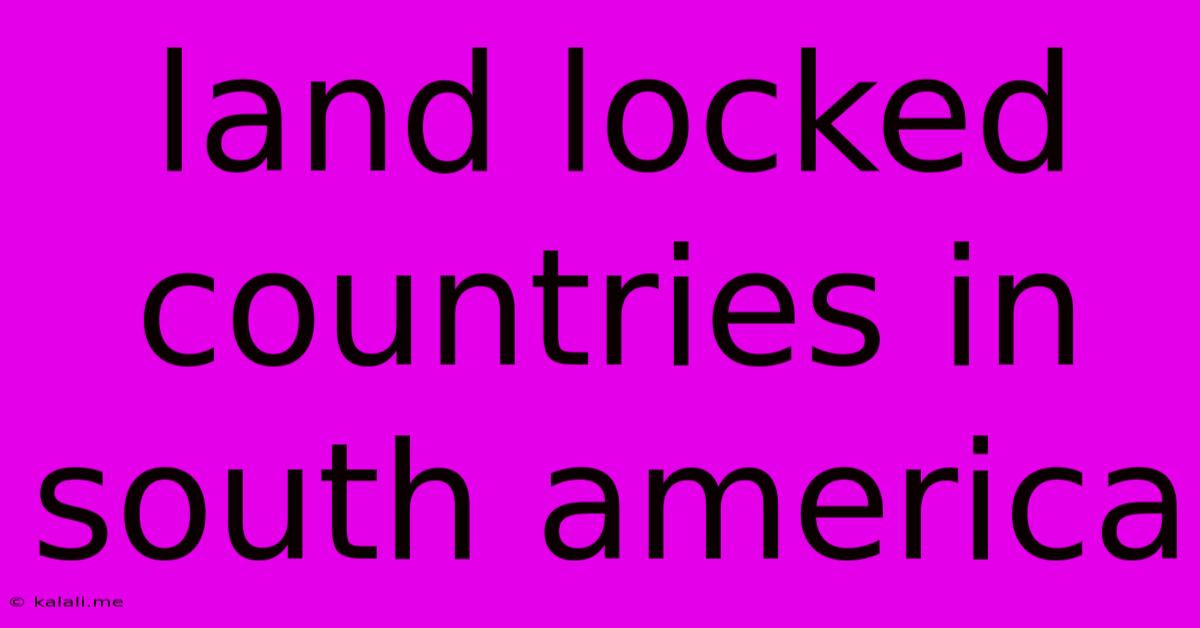Land Locked Countries In South America
Kalali
Jun 12, 2025 · 3 min read

Table of Contents
Landlocked Countries in South America: A Geographic and Economic Overview
South America, a continent known for its stunning landscapes and diverse cultures, boasts a fascinating mix of coastal and inland nations. While many associate the continent with its extensive coastline, two countries are uniquely positioned as landlocked nations: Bolivia and Paraguay. This article will delve into the geographical characteristics, economic challenges, and unique features of these two South American landlocked countries. Understanding their situations offers a compelling perspective on the diverse realities within the continent.
Bolivia: The Heart of South America
Bolivia, situated in the central Andes, is the largest landlocked country in South America. Its geography is exceptionally diverse, encompassing the high Andes Mountains, the Altiplano plateau (home to Lake Titicaca, the highest navigable lake in the world), and the Amazon Basin. This varied topography contributes to Bolivia's rich biodiversity and its unique cultural tapestry, encompassing indigenous communities with distinct traditions. However, this geographical diversity also presents significant challenges in terms of infrastructure development and economic integration.
Economic Challenges and Opportunities:
- Limited Access to Ports: Bolivia's landlocked status significantly impacts its trade and economic development. Access to international markets relies heavily on neighboring countries' ports, leading to potential bottlenecks and increased transportation costs. This dependence can impact trade negotiations and influence economic stability.
- Resource Wealth: Bolivia is richly endowed with natural resources, including lithium (crucial for electric vehicle batteries), natural gas, and minerals. Strategic management and investment in these resources are crucial for sustainable economic growth.
- Tourism Potential: Bolivia's breathtaking landscapes and vibrant culture provide significant tourism potential. Developing sustainable tourism practices that benefit local communities is vital for generating income and protecting the environment.
Paraguay: Navigating the Inland Waterways
Paraguay, nestled in the heart of South America, shares a landlocked status with Bolivia, but its geographical character is distinctly different. Unlike Bolivia’s mountainous terrain, Paraguay is largely comprised of flat plains, predominantly the Gran Chaco region. The Paraguay River and its tributaries, however, play a crucial role in Paraguay's connectivity and economy.
Economic Factors and Development:
- River Transportation: The Paraguay River system provides a vital transport network for Paraguay, facilitating trade with neighboring countries and access to international markets. This water-based infrastructure is significantly less expensive than reliance solely on land-based transport.
- Agricultural Potential: Paraguay's fertile plains are ideally suited for agriculture, leading to significant production of soybeans, corn, and other agricultural goods. This sector is a major contributor to the nation's economy, although vulnerability to global commodity prices remains a concern.
- Hydroelectric Power: Paraguay's rivers also offer a substantial source of hydroelectric power, fostering energy independence and potential for export. The Itaipu Dam, shared with Brazil, is one of the world's largest hydroelectric power plants.
Comparison and Conclusion:
Both Bolivia and Paraguay face the common challenge of being landlocked, impacting their trade and economic development. However, their distinct geographical features and resource endowments lead to varying economic strategies and opportunities. Bolivia's focus on resource extraction and tourism contrasts with Paraguay's reliance on its extensive river systems and agricultural production. Both countries, however, are working to overcome their geographical limitations through strategic infrastructure development, regional cooperation, and diversification of their economies. Their unique stories demonstrate the resilience and adaptability of nations navigating the complexities of geography and global markets. Their future prosperity depends greatly on effective governance, investment in infrastructure, and sustainable resource management.
Latest Posts
Latest Posts
-
Who Identified Triads Of Elements With Similar Properties
Jun 13, 2025
-
What Is The Boiling Point On The Fahrenheit Scale
Jun 13, 2025
-
What Are The Dimensions Of Force
Jun 13, 2025
-
Area Enclosed By Two Curves Calculator
Jun 13, 2025
-
2 Largest Ocean In The World
Jun 13, 2025
Related Post
Thank you for visiting our website which covers about Land Locked Countries In South America . We hope the information provided has been useful to you. Feel free to contact us if you have any questions or need further assistance. See you next time and don't miss to bookmark.